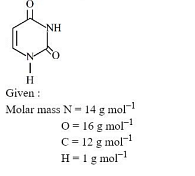Question:
Given below are two statements:
I. Cytosine and guanine are formed in equal quantities in DNA hydrolysis.
II. Adenine and uracil are formed in equal quantities in RNA hydrolysis. The correct answer is:
Given below are two statements:
I. Cytosine and guanine are formed in equal quantities in DNA hydrolysis.
II. Adenine and uracil are formed in equal quantities in RNA hydrolysis. The correct answer is:
I. Cytosine and guanine are formed in equal quantities in DNA hydrolysis.
II. Adenine and uracil are formed in equal quantities in RNA hydrolysis. The correct answer is:
Show Hint
In DNA, cytosine and guanine are always found in equal quantities due to complementary base pairing, but this does not apply to adenine and uracil in RNA.
Updated On: May 18, 2025
- Statements I, II both are correct
- Statements I, II both are incorrect
- Statement I is correct but statement II is incorrect
- Statement I is incorrect but statement II is correct
Hide Solution
Verified By Collegedunia
The Correct Option is C
Approach Solution - 1
Step 1: Understanding DNA Base Pairing
- DNA follows Chargaff’s rule, which states that the number of cytosine (C) equals the number of guanine (G), and the number of adenine (A) equals the number of thymine (T).
- Hence, in DNA hydrolysis, cytosine and guanine are produced in equal quantities.
Step 2: RNA Hydrolysis and Base Pairing
- RNA consists of adenine (A), uracil (U), cytosine (C), and guanine (G).
- Unlike DNA, RNA does not follow Chargaff’s rule because it is single-stranded.
- Adenine and uracil are not necessarily in equal amounts in RNA hydrolysis.
Thus, statement I is correct, but statement II is incorrect.
Was this answer helpful?
0
0
Hide Solution
Verified By Collegedunia
Approach Solution -2
Given below are two statements:
I. Cytosine and guanine are formed in equal quantities in DNA hydrolysis.
II. Adenine and uracil are formed in equal quantities in RNA hydrolysis.
Analysis:
Statement I:
In double-stranded DNA, cytosine pairs with guanine through three hydrogen bonds. Because of base pairing rules (Chargaff's rule), the number of cytosine (C) bases always equals the number of guanine (G) bases. Hence, during hydrolysis of DNA, cytosine and guanine are released in equal quantities.
So, Statement I is correct.
Statement II:
In RNA, adenine pairs with uracil during base pairing, but RNA is typically single-stranded. There is no strict base pairing rule that ensures equal quantities of adenine and uracil. Therefore, adenine and uracil are not necessarily present in equal amounts in RNA hydrolysis.
So, Statement II is incorrect.
Conclusion:
The correct answer is:
Statement I is correct but Statement II is incorrect.
I. Cytosine and guanine are formed in equal quantities in DNA hydrolysis.
II. Adenine and uracil are formed in equal quantities in RNA hydrolysis.
Analysis:
Statement I:
In double-stranded DNA, cytosine pairs with guanine through three hydrogen bonds. Because of base pairing rules (Chargaff's rule), the number of cytosine (C) bases always equals the number of guanine (G) bases. Hence, during hydrolysis of DNA, cytosine and guanine are released in equal quantities.
So, Statement I is correct.
Statement II:
In RNA, adenine pairs with uracil during base pairing, but RNA is typically single-stranded. There is no strict base pairing rule that ensures equal quantities of adenine and uracil. Therefore, adenine and uracil are not necessarily present in equal amounts in RNA hydrolysis.
So, Statement II is incorrect.
Conclusion:
The correct answer is:
Statement I is correct but Statement II is incorrect.
Was this answer helpful?
0
0
Top Questions on Nucleic Acids
Nucleotides are joined together by:
- CBSE CLASS XII - 2025
- Chemistry
- Nucleic Acids
- Two nucleotides are joined together by a linkage known as:
- JEE Main - 2024
- Chemistry
- Nucleic Acids
- Assertion (A): Uracil base is present in DNA. Reason (R): DNA undergoes self-replication.
- CBSE CLASS XII - 2024
- Chemistry
- Nucleic Acids
- Identify the polarity from ‘X’ to ‘Y’ in the mRNA segment shown. Mention how many more amino acids can be added to the polypeptide that is being translated and why.
- CBSE CLASS XII - 2024
- Biology
- Nucleic Acids
- Uracil is a base present in RNA with the following structure $\%$ of $N$ in uracil is ___

- JEE Main - 2023
- Chemistry
- Nucleic Acids
View More Questions
Questions Asked in AP EAPCET exam
- At T(K), a gaseous mixture contains H\(_2\) and O\(_2\). The total pressure of the mixture is 2 bar. The weight percentage (w/w) of H\(_2\) is 33.33%. What is the approximate ratio of partial pressure of H\(_2\) and O\(_2\)?
- AP EAPCET - 2025
- States of matter
- If a constant force of \((2i + 3j + 4k) \, \text{N}\) acting on a body of mass \(5 \, \text{kg}\) displaces it from \((3i - 4k)\, \text{m}\) to \((2i + 2j + 3k)\, \text{m}\), then the work done by the force on the body is:
- AP EAPCET - 2025
- Elastic and inelastic collisions
- Assertion (A): Trichomes help in preventing water loss due to transpiration.
Reason (R): The specialized cells near the guard cells together constitute stomatal apparatus.- AP EAPCET - 2025
- Anatomy of Flowering Plants
- The correct order of atomic radii of C, Al and S is
- AP EAPCET - 2025
- Inorganic chemistry
- A parallel plate capacitor has plates of area 0.4 m$^2$ and spacing of 0.5 mm. If a slab of thickness 0.5 mm and dielectric constant 4.5 is introduced between the plates of the capacitor, then the capacitance of the capacitor is
- AP EAPCET - 2025
- Capacitors and Capacitance
View More Questions